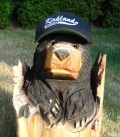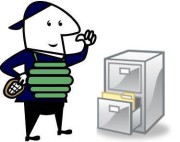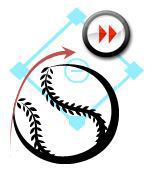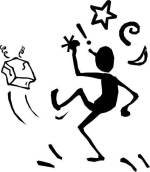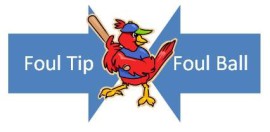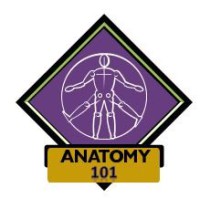Umpiring Tips Archive - 2
Welcome to the Umpire Tips Archive – additional tips you’ll find useful at any experience level.
Game End – Leave the Field Promptly
Speeding Up the Game by Rotating Balls
Handling Manager and Coach Ejections
Myths Demystified – "The hands are considered part of the bat"
June Tip: Game End – Leave the Field Promptly
- After the game ends, it's fine to acknowledge any thanks from coaches and players. But be brief.
- The playing field following a game is not the right place or time to rehash calls or answer questions. Doing so could invite an emotional response from a coach who had issue with a call or prompt suspicions of favoritism. Outbursts are more likely to occur right after the game. Your conversation on the playing field could also invite public viewing and spectacle.
- If someone wants to speak with you about the game or a call, tell them you'd be happy to do so at another time. You'll both have the benefit of more time to consider a potentially complicated call or ruling. Emotions tend to calm down too with the passage of a little time and perspective.
- After the last out is made, meet with your fellow umpires at the pitcher's mound and leave together. Some umpire teams like to leave through the winning team's dugout exit, generally a more favorable path. Others may choose to leave through the exit that is closest to the parking lot following a controversial game!
- Regardless of the circumstances, the brief time following the game should be left to the players and coaches to shake hands in good sportsmanship and enjoy applause from their fans. You'll avoid potential issues by making a prompt and professional exit from the playing field and be in a better position to handle questions that are postponed to a later time.
May Tip: Speeding up the Game by Rotating Balls
- As the plate umpire, you can speed up the game by rotating balls.
- During play
- Foul balls hit to the backstop area: throw an extra ball (from your ball bag) to the pitcher while the catcher retrieves the foul ball. Only rotate foul balls since they result in a dead ball situation.
- Foul balls to an outfielder: instruct the fielder to give the ball to a base umpire while you throw a new ball to the pitcher. The base umpire can return the foul ball to you later between innings.
- Foul balls to an infielder: instruct the fielder to throw the ball to the catcher while you throw a new ball to the pitcher.
- During pitcher warm ups
- After a passed ball, give the catcher one of your extra balls to continue the warm up. You'll gather the passed balls from the backstop area (be aware of new pitches from behind!). This makes efficient use of the pitcher's limited warm up time.
- Especially with younger players, rotating balls over the course of a game will prevent wild throws back into the pitcher which burn up a lot of potential playing time.
- After a few innings, the catchers and fielders will develop a rhythm with the umpires. Rotating balls keeps the players engaged and attentive. They'll chase down balls more quickly when they know the umpire and pitcher are waiting on them.
- Rotating balls can have a significant impact on speeding up the game. Fifteen such foul and passed balls per inning could easily save 15 minutes of wasted time per game! But most of all, it keeps the game moving.
April Tip: Handling Manager and Coach Ejections
- Deciding when to eject a coach from a game can be difficult. You should be neither too quick to pull the trigger nor too willing to take inappropriate, prolonged behavior that undermines your credibility and authority.
- Eject a Manager or Coach when it involves any of the "five P's". When it's ...
- physical (contact in anger or threatening).
- personal (i.e. "you're a bad umpire"). You should let something like "oh, that was a bad call" go if stated once and then dropped.
- profane (as in profanity). The louder it is, the more likely to eject.
- prolonged (won't stop when told to).
- persistent (continues to bring up call from earlier). Example: ongoing "chirping" from the dugout about a call.
- Provide a warning to allow the person to compose himself before it reaches the point of above. You might say: "Coach, I'm not going to listen to this all day", or "Coach, I
can't allow you to interrupt the game any longer. Let's play."
- When you eject someone, do so quietly (not like in ESPN highlights). If not, the offending person will just exchange your drama with more drama of his own. Try to have your back to the stands and him facing the fans. If you're composed and he's not, everyone will take notice. Something like: "Coach, you're done. Please leave the park. We'll start again after you've left."
- The ejected coach must leave not just the playing field, but also the park grounds. If he refuses, have all the players remain in the dugout with play suspended. Eventually the peer pressure and spotlight will prompt him to leave. Otherwise, wait ten minutes or so and call the game as a forfeit if it comes down to it (it won't). Your league will likely require you to write and submit your account of the incident within 24 hours.
- Fortunately, poor behavior resulting in ejection does not happen often and when it does, repeat offenders don't stay coaches for very long.
March Tip: A Foul Tip is Not a Foul Ball
- Foul tips and foul balls share similar names. But they're quite different.
- Most importantly, each determines whether subsequent play continues to be live or not. Inexperienced players (and coaches) may erroneously continue or stop play when they should do otherwise, contributing to on-field mayhem.
The differences
| A Foul Tip ... | A Foul Ball ... |
| is a batted ball that goes sharp and direct from the bat to the catcher’s hands and is caught. | is a batted ball that lands anywhere in foul territory and is not caught (in the case of a fly foul ball). |
| is a strike and if 3rd strike, batter’s out. | is a strike and if 3rd strike, at-bat continues. |
| continues to be a live ball. Play can continue, including runners. | becomes a dead ball. Play halts and runners are returned to their bases. |
And to add to the confusion
| A Foul Tip ... | A Foul Ball ... |
| if dropped, becomes a dead ball (like a foul ball)! | if caught (in the air), is a live ball play (like a foul tip!) |
As a plate umpire, you can keep the game moving smoothly by using the proper techniques to ensure coaches and players know you called a foul tip or a foul ball.
| Home Plate Umpire Video – Calling a Foul Tip | Home Plate Umpire Video – Calling a Foul Ball |
For base umpires, mimic a foul ball call by your partners by signaling foul and loudly yell “foul!” if you see runners and defenders continuing play.
February Tip: Myths Demystified – "The hands are considered part of the bat"
- This is a common misconception. As the thinking goes, if a pitched ball hits the batter's hands, then one could conclude a foul ball or hit could result. Wrong! When you hear a coach or spectator make this argument, your immediate reactions are:
- Call "Time"! A ball that hits a batter's body always results in a dead ball. Return any runners to their bases.
- To anyone making this argument, show him how his hand is permanently connected to their arm, not to the bat!
- Your decision to call a ball or strike and potentially award a base is made as if any other part of the batter's body was hit by the ball.
- If the batter swung at the ball - a strike is called.
- If the ball passed through the strike zone - a strike is called.
- If the ball did not pass through the strike zone - a "hit batter" is called and the batter is awarded first base, assuming he made a reasonable attempt to avoid the ball.
- And in the case of #3, when the batter did not make an attempt to avoid the ball - a ball is called.
- It's often hard to see whether a ball hit a batter's hands. Sometimes you can tell by the muffled sound versus the "ping noise" of a ball making full contact with the bat. But most often, you'll decide based on the combination of contact location and the batter's immediate, physical and verbal response (aka "@#!ouch!%!).

